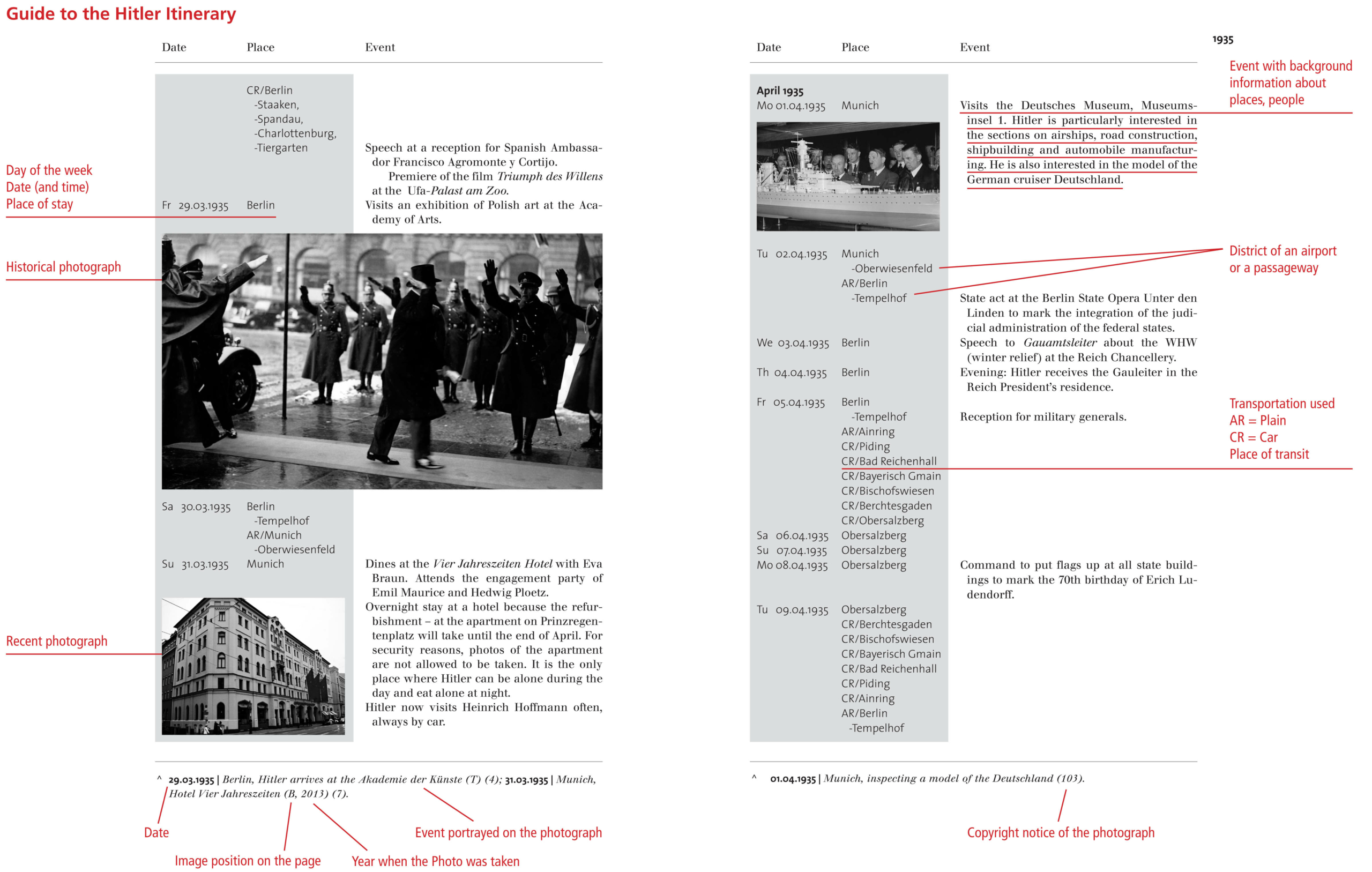
Hitler – The Itinerary
Whereabouts and Travels from 1889 to 1945
Author: Harald Sandner
ISBN: 978-3-95723-180-2
Edition English. 4 volumes, together 2432 pages + text-CD (CD with the identical text as in the book, to be used as an index for the four volumes. There are no photos on the CD), 2215 illustrations, 240 mm X 170 mm. The books come in a slipcase to protect them in transportation. Price: €499 — NOW only 99 € + Shipping Europe 10 €, worldwide 30€. Delivery to the USA currently takes two weeks. Europe one week.
These four volumes contain the largely complete chronology of the whereabouts and travels of the German dictator Adolf Hitler (1889-1945). Where Hitler was, there was the power. That is why his movement profile is important.
Essential political, military and personal events that are the reasons for Hitler‘s journeys or stays are presented chronologically. Notes complete the work on the whereabouts of Hitler‘s travel habits, his places of residence, the means of transport he used and the remains of his corpse. The appendix contains statistics on the frequency of his visits in selected cities and on the outcome of the Second World War.
Thus, as a outline of Hitler‘s life, this itinerary presents a hitherto unknown view of his biography and is unique in the world in its form, scope and attention to detail. 1,494 historical photos and 721 contemporary photos – 75 % of which have never before been published. By comparing these images with photos of sites that still exist today, facts, figures and information from the past are seemingly brought to life.
„The Itinerary is really very helpful for us. We use it every day.“ – Dr. Erik Somers, NIOD, Instituut voor Oorlogs-, Holocaust- en Genocidestudies, Amsterdam
„The work’s accuracy makes it absolutely indispensable for research.“ – Professor Laurenz Demps, Humboldt Universität Berlin
„The Itinerary is of outstanding importance for basic research on the Holocaust.“ – Dr David Th. Schiller, Israeli political scientist
„I know the German Hitler Itinerary very well. It’s great that it’s now coming out in English.“ – Professor Sascha Becker, University of Warwick
„This is the best documentary on the life of the leader of the Third Reich.“ – Prof. Dr. Don A. Gregory, University Distinguished Professor at the University of Alabama in Huntsville
„With the Itinerary, after more than 80 different serious biographies, for the first time a truly detailed basis for the description of Hitler’s life is available … It belongs without doubt in every specialist library worldwide.“ – Sven Felix Kellerhoff, Historian, Berliner Morgenpost
„The result is a definitive work that no historian who deals intensively with Hitler can do without in the future.“– Armin Fuhrer, Historian, Dagbladet, Norway
„As a reference work for scholars and history buffs, Hitler –The Itinerary fills a significant gap in research on the dictator.“ – Marc von Lüpke, SPIEGEL
„Sandner has created an absolute novelty. His Hitler Itinerary is incredibly exciting; it is a tour de force to have planned and executed such a project. It has an inestimable significance for me.“ – Volker Elis Pilgrim, Sociologist, New Zealand
„Anyone who wants to deal with Adolf Hitler in any way in the future will have to consult this work.“ – Antonia Kleikamp, WELT
„Sandner’s merit. Meticulously lists Adolf Hitler’s whereabouts with details of the locations of individual speeches and meetings with patrons, minions, and opponents.„ – Professor Rainer Blasius, FAZ
Meet Harald Sandner in person and join him in his research, documented in the two 50-minutes TV-films Magalie Mignot wrote and directed about the Hitler Itinerary, Part 1: The Ascent of a Criminal and part 2: The War Leader.
Harald Sandner: „The Itinerary was created between 1983 and 2016 – with some interruptions. After its publication in 2016, it was supplemented in details by the kind contribution of many historians.“
How does the Itinerary work?
Where was this Itinerary cited?
The Hitler Itinerary, since it was published, has been cited in almost all books on National Socialism published thereafter. Examples:
„Das Reichsarbeitsministerium im Nationalsozialismus“, edited by the Historikerkommission Reichsarbeitsministerium under the direction of Professor Alexander Nützenadel, Wallstein, 2017.
„German Yearbook of Contemporary History“, edited by Professor Elizabeth Harvey, Nottingham, and Professor Johannes Hürter, Gutenberg University Mainz, De Gruyter Oldenburg, 2018.
„Edition of Adolf Hitler’s Speeches from 1933 to 1945“, edited by Professor Magnus Brechtken, Deputy Director of the Institute of Contemporary History, Munich, 2019.
„150 Years of Nation-Statehood in Germany“, Professor Tilman Mayer, Nomos, 2020.
„Hitler’s Fatal Miscalculation“, by military historian Dr. Klaus H. Schmider of Sandhurst, Cambridge University Press, 2021.
„Hitlers Vater: Wie der Sohn zum Diktator wurde“, Professor Roman Sandgruber, Vienna 2021.
Why is the Itinerary necessary and what misadventures happened to historians before the Itinerary existed?
What happened before the Itinerary was published? Did Hitler take a well-earned vacation after seizing power? Two examples:
1. In his 1000-page biography, an author states that Hitler went on vacation after the seizure of power. „The summer vacation of 1933 therefore marks a caesura in Hitler’s dealings with the government. He demonstratively took a political break. Instead of large gatherings, summer pleasures now dominated the public scene,“ it says under the heading „Summer Break.“ In fact, as the itinerary shows, he was in Bayreuth, traveled to Berlin and Munich within five days, accepted honorary citizenship of Stuttgart, spoke at the German Gymnastics Festival and met the Gauleiters on Obersalzberg, conferred with Reich Economics Minister Kurt Schmitt and received his old NSDAP comrades-in-arms Hermann Göring and Hermann Esser. He also went to speak at a Richard Wagner memorial service at Neuschwanstein Castle, and traveled by car to Nuremberg, Wiesbaden, and Bad Godesberg, where he spoke before SA and SS leaders.
The return trip went via Würzburg and Nuremberg to Obersalzberg. He stayed there for three days before being chauffeured by car to Berlin and departing from Tempelhof Airport to East Prussia for the state ceremony with Reich President Paul von Hindenburg at the Tannenberg Monument. This book was published in 2015. The author was unable to work with the itinerary.
2. When was Hitler actually in Paris? The numerous photos prove that he visited Paris – no question, nobody doubts that. Harald Sandner: „Hitler’s one-time visit to Paris illustrates particularly well the problems of precisely dating Hitler’s whereabouts. Even participants in the trip such as Albert Speer and Nicolaus von Below later misstated the date.“ They both wrote in their memoirs, published in 1969 and 1980, that the visit to Paris took place on June 28, 1940. In contrast, the sculptor Arno Breker, Hitler’s private secretary Christa Schroeder and his valet Heinz Linge in their memoirs hand down June 23, 1940 as the date of the short visit. To make it even more complicated, the architect Hermann Giesler named June 24 – and France’s later prime minister Pierre Mendès-France, an air force officer in 1940, spoke of June 15, 1940. A member of the Institute for Austrian Historical Sciences constructed two secret visits from the dates June 23, 1940 and June 28, 1940, which had taken place almost identically. She wrote this before the Hitler Itinerary had come out.
From the Content:
– On the research situation
– Hitler’s travel habits
– Hitler’s election campaigns
– Hitler’s speeches
– Hitler’s official and unofficial travels
– Führer headquarters
– Excursuses: What happened to Hitler’s body? Where did Hitler live? What means of transportation did Hitler use? Statistics on Hitler’s stays in selected places. Balance of the Second World War – a description in figures.
Reading and media
- Press review and voices on the book / Presseschau und Stimmen zum Buch
- Pressemappe inkl. Auszügen aus allen Bänden, 60 Buchseiten von 2432
- Introduction / Einleitung (gekürzt)
- Foreword of the author / Vorwort des Autors
Reading sample
http://www.berlinstory-verlag.de/wp-content/uploads/2021/08/Hitler_Itinerary.pdf
Where is Hitler’s dead body?
Hitler did not escape to Argentina. An eight-episode series on HISTORY CHANNEL suggests he did. Absurd. What happened to Hitler’s body? Here is an extract from the detailed twelve-page feature:
Station 6
3 June 1945, sixth funeral: the Russian general Mesik arrives from Moscow. The bodies are exhumed once more and transported to Rathenow, 125 kilometres away. Here they are buried on the outskirts of the town in a forest. Pine trees are planted on the grave as camouflage. On 9 June, Russian Marshal Zhukov claims at a press conference in Berlin that several bodies have been found and that it is not certain that Hitler is really dead. This is a false claim made on purpose.
Station 8
Thursday, 21 February 1946 „… The eighth burial takes place in a „two-metre-deep pit“ in the courtyard of Westendstrasse 32 at the Smersh Division of the 3rd Shock Army. Lieutenant General Kobulow thus no longer has access and cannot substantiate his execution thesis …“
Station 10
5 April 1970, tenth burial: Because the military settlement is to be handed over to the GDR authorities, KGB chief Yuri Andropov has the remains finally destroyed. Five KGB officers exhume Hitler’s body for the ninth time under the protection of a tent on 4 April. The bones of all ten bodies are relocated in Kalashnikov boxes …“
The Hitler Itinerary has nothing to do with the annotated edition of Hitler’s book Mein Kampf, which was published at almost the same time. In Mein Kampf, Hitler wants to make it clear to readers how they should see him. The Hitler Itinerary is about what Hitler did on each day of his life, how he moved, who he met, what it was all about.


